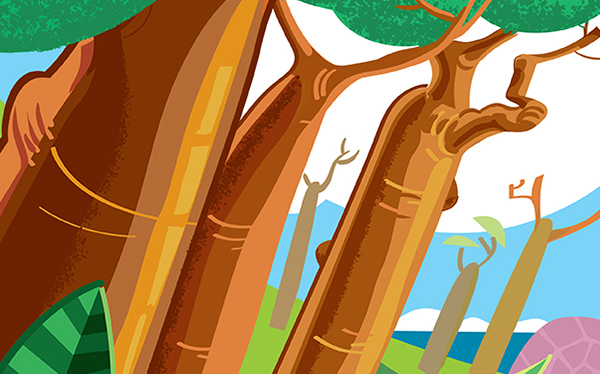Adansonia digitata (baobab) is the most widespread of the Adansonia species on the African continent, found in the hot, dry savannahs of sub-Saharan Africa. Common names for the baobab include dead-rat tree (from the appearance of the fruits), monkey-bread tree (the soft, dry fruit is edible), upside-down tree (the sparse branches resemble roots), cream of tartar tree (cream of tartar) and गोरख चिंच in marathi (meaning monkey’s tamarind).
The scientific name of the Baobab, Adansonia digitata comes from the French explorer and botanist, Michel Adanson (1727-1806). He officially discovered it in 1749 on the island of Sor in Senegal.[2] He concluded of all the trees he studied, the baobab “is probably the most useful tree in all.” He consumed baobab juice twice a day, while in Africa. He remained convinced that it maintained his health for him.[3]“Digitata” refers to the digits of the hand. The baobab’s branches and leaves are akin to a hand.
All baobab trees are deciduous trees, meaning they lose their leaves in the dry season. They can reach from 5– 25 meters in height. In fact, they are known both for their height and their girth. Its trunk tends to be bottle-shaped and can reach a diameter of 10–14 m.[4]
The trunk is smooth and shiny[5] and can range from being reddish brown to grey. The bark can feel cork-like.[3] The branches are thick and wide and very stout compared to the trunk. It has large, white flowers (12 cm across) that open at night.[4] The flowers have 5 petals that are hairy inside and leathery. The sepals are cup-shaped and 5-cleft. The stamens are divided into multiple anthers and stylesare 7-10 rayed. The flowers have a lifespan of about 24 hours.[4]
The baobab is leafless for nine months of the year. Many consider the tree to be “upside-down” due to its trunk likeness to ataproot and the branches akin to the finer capillary roots. The roots of the tree actually span larger than the height. This allows the tree to survive well in a dry climate.
(From Wikipedia, August 2015)





